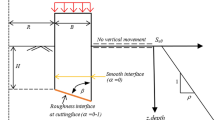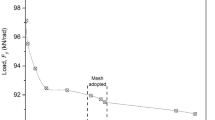Abstract
Pile foundations are often subjected to lateral pressures in addition to axial loads due to earthquakes, ground pressure, and wind pressures in various buildings. As a result, pile foundations have gotten more research than any other type of foundation. Furthermore, estimating the lateral load capacity of a pile (LLCP) accurately is a difficult undertaking, and there has been relatively little study in this field. To overcome these problems, in this study, the adaptive neuro-fuzzy inference system (ANFIS) was ustilized to construct forecasting models for the indirect assessment of LLCP embedded in clay in this work. The fuzzy c-means clustering technique (FCM) and the subtractive clustering method (SCM) were implemented as ANFIS models. The data from open-source literature were used to evaluate the two ANFIS models. In these models, pile length (L), pile diameter (D), undrained shear strength of soil (Su), and eccentricity of load (e) were used as the inputs, while the measured LLCP in clay was the output. To compare the performance of the estimating models, several statistical performance measures were used. The modeling results show that the relationships determined for estimating the LLCP in clay by ANFIS models (ANFIS-SCM and ANFIS-FCM) are accurate and close to the real value. It can also be concluded that the use of ANFIS models to predict the LLCP in clay is very efficient.









Similar content being viewed by others
Data availability
The dataset used in this study was compiled from open-access literature (Rao and Suresh Kumar 1996).
References
Alkroosh I, Nikraz H (2013) Evaluation of pile lateral capacity in clay applying evolutionary approach. Int J Geomate 4:462–465
Babanouri N, Fattahi H (2020) An ANFIS–TLBO criterion for shear failure of rock joints. Soft Comput 24:4759–4773. https://doi.org/10.1007/s00500-019-04230-w
Begum N, Muthukkumaran K (2009) Experimental investigation on single model pile in sloping ground under lateral load. Int J Geotech Eng 3:133–146
Bezdek JC (1973) Fuzzy mathematics in pattern classification. Cornell University, Ithaca
Brinch-Hansen J (1961) The ultimate resistance of rigid piles against transversal forces, Geoteknisk Instit, Bull
Broms BB (1964a) Lateral resistance of piles in cohesionless soils. J Soil Mech Found Div 90:123–156
Broms BB (1964b) Lateral resistance of piles in cohesive soils. J Soil Mech Found Div 90:27–63
Brown DA, Hidden SA, Zhang S (1994) Determination of py curves using inclinometer data. Geotech Test J 17:150–158
Chan W, Chow Y, Liu L (1995) Neural network: an alternative to pile driving formulas. Comput Geotech 17:135–156
Chiu SL (1994) Fuzzy model identification based on cluster estimation. J Intell Fuzzy Syst 2:267–278
Chopra S, Mitra R, Kumar V (2006) Reduction of fuzzy rules and membership functions and its application to fuzzy PI and PD type controllers. Int J Control Autom Syst 4:438
Das SK, Basudhar PK (2006) Undrained lateral load capacity of piles in clay using artificial neural network. Comput Geotech 33:454–459
Das SK, Biswal RK, Sivakugan N, Das B (2011) Classification of slopes and prediction of factor of safety using differential evolution neural networks. Environ Earth Sci 64:201–210
Elgamal A, Elnimr A, Ahmed Dif AE-SN, Gabr A (2021) Prediction of pile bearing capacity using artificial neural networks (Dept C). MEJ Mansoura Eng J 37:1–14
Fattahi H (2016a) Adaptive neuro fuzzy inference system based on fuzzy C–means clustering algorithm, a technique for estimation of TBM peneteration rate. Int J Optim Civ Eng 6:159–171
Fattahi H (2016b) Indirect estimation of deformation modulus of an in situ rock mass: an ANFIS model based on grid partitioning, fuzzy c-means clustering and subtractive clustering. Geosci J 20:681–690. https://doi.org/10.1007/s12303-015-0065-7
Fattahi H (2017) Applying soft computing methods to predict the uniaxial compressive strength of rocks from schmidt hammer rebound values. Comput Geosci 21:665–681
Fattahi H, Bazdar H (2017) Applying improved artificial neural network models to evaluate drilling rate index. Tunn Undergr Space Technol 70:114–124
Fattahi H, Hasanipanah M (2021) An integrated approach of ANFIS-grasshopper optimization algorithm to approximate flyrock distance in mine blasting. Eng Comput. https://doi.org/10.1007/s00366-020-01231-4
Fattahi H, Shojaee S, Farsangi ME (2013) Application of adaptive neuro-fuzzy inference system for the assessment of damaged zone around underground spaces. Int J Optim Civ Eng 3:673–693
Goh A (1995) Empirical design in geotechnics using neural networks. Geotechnique 45:709–714
Goh AT (1996) Pile driving records reanalyzed using neural networks. J Geotech Eng 122:492–495
Jahed Armaghani D, Harandizadeh H, Momeni E (2021) Load carrying capacity assessment of thin-walled foundations: an ANFIS–PNN model optimized by genetic algorithm. Eng Comput. https://doi.org/10.1007/s00366-021-01380-0
Jang JSR (1993) ANFIS: adaptive-network-based fuzzy inference system. IEEE Trans Syst Man Cybern 23:665–685
Karimpouli S, Fattahi H (2018) Estimation of P-and S-wave impedances using Bayesian inversion and adaptive neuro-fuzzy inference system from a carbonate reservoir in Iran. Neural Comput Appl 29:1059–1072
Kiefa MA (1998) General regression neural networks for driven piles in cohesionless soils. J Geotech Geoenviron Eng 124:1177–1185
Li X, Zhong D, Ren B, Fan G, Cui B (2019) Prediction of curtain grouting efficiency based on ANFIS. Bull Eng Geol Environ 78:281–309. https://doi.org/10.1007/s10064-017-1039-y
Matlock H, Reese LC (1962) Generalized solutions for laterally loaded piles. Trans Am Soc Civ Eng 127:1220–1248
Mohammadi H, Rahmannejad R (2010) The estimation of rock mass deformation modulus using regression and artificial neural networks analysis. Arab J Sci Eng 35:205
Muduli PK, Das MR, Samui P, Kumar Das S (2013) Uplift capacity of suction caisson in clay using artificial intelligence techniques. Mar Georesour Geotechnol 31:375–390
Muthukkumaran K (2014) Effect of slope and loading direction on laterally loaded piles in cohesionless soil. Int J Geomech 14:1–7
Muthukkumaran K, Sundaravadivelu R, Gandhi S (2008) Effect of slope on py curves due to surcharge load. Soils Found 48:353–361
Poulos HG, Davis EH (1980) Pile foundation analysis and design, vol Monograph
Rao K, Suresh Kumar V (1996) Measured and predicted response of laterally loaded piles. In: Proceedings of the sixth international conference and exhibition on piling and deep foundations, India, pp 1–16
Rasouli H, Fatahi B (2021) Geosynthetics reinforced interposed layer to protect structures on deep foundations against strike-slip fault rupture. Geotext Geomembr 49:722–736
Samui P (2008) Prediction of friction capacity of driven piles in clay using the support vector machine. Can Geotech J 45:288–295
Smuda J, Dold B, Friese K, Morgenstern P, Glaesser W (2007) Mineralogical and geochemical study of element mobility at the sulfide-rich excelsior waste rock dump from the polymetallic Zn–Pb–(Ag–Bi–Cu) deposit, Cerro De Pasco. Peru J Geochem Explor 92:97–110
Talal Alfach M, Al Helwani A (2021) Seismic interactions between adjacent and crossing bridges on deep foundations in nonlinear soil. Geomech Geoeng 16:163–181
Tan M, Cheng X, Vanapalli S (2021) Simple approaches for the design of shallow and deep foundations for unsaturated soils I: theoretical and experimental studies. Indian Geotech J 51:97–114
Tarawneh B, Imam R (2014) Regression versus artificial neural networks: predicting pile setup from empirical data. KSCE J Civ Eng 18:1018–1027
Teh C, Wong K, Goh A, Jaritngam S (1997) Prediction of pile capacity using neural networks. J Comput Civ Eng 11:129–138
Funding
The authors have not disclosed any funding.
Author information
Authors and Affiliations
Contributions
Conceptualization, methodology, software, validation, investigation, data curation, writing—review and editing, supervision: HF.
Corresponding author
Ethics declarations
Conflict of interests
The authors have not disclosed any conflict of interests.
Additional information
Publisher's Note
Springer Nature remains neutral with regard to jurisdictional claims in published maps and institutional affiliations.
Rights and permissions
Springer Nature or its licensor (e.g. a society or other partner) holds exclusive rights to this article under a publishing agreement with the author(s) or other rightsholder(s); author self-archiving of the accepted manuscript version of this article is solely governed by the terms of such publishing agreement and applicable law.
About this article
Cite this article
Fattahi, H. Applying computational intelligence methods to evaluate lateral load capacity for a pile. Soft Comput 27, 8919–8929 (2023). https://doi.org/10.1007/s00500-022-07801-6
Accepted:
Published:
Issue Date:
DOI: https://doi.org/10.1007/s00500-022-07801-6




